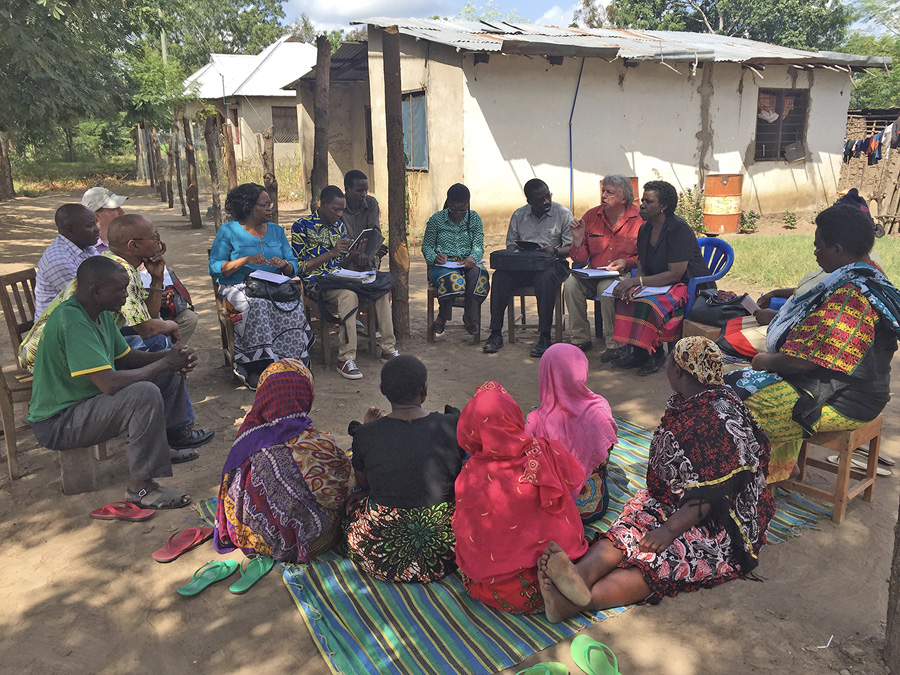Poultry Industry Grows across East Africa, but Challenges Remain

The global poultry population is approximately 16.2 billion, of which 71.6 percent is found in developing countries. Chickens are the most popular poultry grown worldwide. In sub-Saharan Africa, rural chicken production makes up about 60 percent of poultry, with indigenous chickens accounting for 70 percent of the total chicken population.
In East Africa, over 80 percent of the human population lives in rural areas, and over 75 percent of these households keep indigenous chickens. Poultry is an inexpensive, quality source of protein and is vital to reducing malnutrition among rural populations. The poultry sector has the potential to promote economic growth in developing countries.
Growth Potential and Challenges of Poultry Production
The poultry industry across East Africa (including the countries of Kenya, Rwanda, Tanzania, and Uganda) has been growing rapidly for the past 8–10 years, driven by rapid urbanization, growth of the middle class, a rise in the number of quick-service restaurants in urban areas, and a growing need for animal protein. Kenya’s poultry sector is the most mature, but the other three East African economies have also made significant inroads to growing and expanding their own poultry sectors.
However, smallholder poultry farmers encounter several challenges, including these:
- rising costs of farm inputs resulting from competition for key raw materials.
- inability to control poultry diseases because of increasing vaccine costs and lack of vaccine and disease knowledge and management.
- limited information regarding both input and output markets.
In fact, improved feeds and necessary vaccinations are the most limiting resources in indigenous poultry production.
A series of other challenges also hinder the growth of the commercial value chain across East Africa. These include the availability and production of high-quality feed at competitive prices. Despite policy changes to incentivize the import of raw materials for feed, challenges remain. For example, the disparity in terms of available land for corn cultivation means the cost and eventual market price for corn differs dramatically across East Africa.
In addition, there is a shortage of day-old chicks across East Africa, making it difficult for farmers to plan and manage their costs.
Finally, access to markets is often difficult. Citizens of the member states are, in principle, allowed to work, do business, and trade with one another freely. However, even though the East African Community is the most advanced economic bloc in Africa, it still faces challenges to implementing certain policies collectively.
The livestock industry contributes one-third of the protein that people consume worldwide, and the poultry sector has been the biggest contributor to the industry’s growth in recent years. Globally, poultry production has grown at more than 5 percent annually since the 1960s. Poultry’s contribution to world meat production doubled from 15 percent in 1960 to 30 percent in 2000.
Poultry products are among the most affordable foods and are a healthy protein source with no religious restrictions. In addition, they have the lowest environmental footprint in terms of water use per kilogram of meat or eggs produced, land use, and environmental stress.
Despite these advantages, indigenous poultry production in rural areas continues to generate unrewarding returns. Although governmental and nongovernmental programs provide support to increase production and bridge the gap between the increasing demand and low supply of poultry products, weak management practices and traditional production practices continue to be used.
Increased Extension Presence Needed
Smallholders are unable to fully utilize available technologies, resulting in low productivity. Additional Extension personnel, particularly women, are needed to help smallholder farmers and disseminate information focused on best management practices, disease control and prevention, proper vaccination procedures, and biosecurity principles (Figure 1).
While some improvements have been noted, many more field livestock Extension workers are needed, and the few existing ones need to be re-trained to equip them with new technologies and motivate them to get out in the field and help clients. Optimal productivity can only be obtained when technology is efficiently used. However, challenges abound, including gender issues, lack of adequate infrastructure, inability to reach individuals in remote areas, and competency levels of Extension personnel.
In addition, multiple other challenges impede the development of an effective supply chain network for poultry meat:
- selfish traders and middlemen
- a fragmented agricultural supply chain
- poor marketing infrastructure for poultry products
- weak transportation infrastructure
- ineffective warehousing and storage facilities
- lack of effective packaging, branding, marketing, and certification of poultry meat produced for local markets
- low productivity of small-scale farmers
- difficulty accessing financing for small-scale farmers
- inadequate safety and security of poultry meat
- lack of sophisticated technology to increase production capacity
- inadequate availability of electrical power
Extension is a source of science-based information, and experts educate farmers on emerging production technologies that promote increased production. Smallholders with increased contacts with Extension experts are better informed and aware of trending issues in both input and output poultry markets. Training in agriculture has a positive and significant impact on technical knowledge, which equips smallholder farmers to increase production levels.
However, most smallholders are not adequately informed on current and emerging issues in poultry production. This limited access to training and Extension programming means rural smallholders have a high risk of uncertainty regarding the overall production process.
Production Systems
The poultry sector in Africa today is a combination of three production systems:
- A local village (backyard) system (low input, low output).
- A commercial production system (high input, high output) that uses exotic hybrid genetic stock in combination with commercial housing, feeding, veterinary, and biosecurity systems.
- An intermediate system (intermediate input, intermediate output).
Because of the rapidly increasing demand for poultry products across East Africa, the contribution of commercial production systems is growing. This growth is expected to continue at an even faster pace in the coming decades as population and urbanization increase and incomes rise. However, while the ratio of village to commercial chickens differs among countries, the largest volume of both eggs and poultry meat is still produced by the local village-type production system across East Africa.
The intermediate production system is gaining in popularity and offers unique opportunities for smallholder farmers to gradually transition from an extensive village production system to a more market-driven system that uses dual-purpose breeds that require somewhat less intensive management than commercial hybrid meat-type breeds. These dual-purpose breeds will thrive on a combination of scavenging supplemented with limited commercial feed, whereas commercial meat-type hybrid birds are not good scavengers and should be fed only a commercial diet.
Summary
Feed (quality and cost), day-old chicks (cost and availability), limited or non-existent vaccination programs, access to markets, and a severe shortage of Extension personnel with poultry expertise are bottlenecks to expanding poultry production across East Africa. Meat consumption, driven particularly by chicken, is at such a level that supply can’t meet demand. The potential is great to develop the poultry industry across East Africa and improve the food security situation, although numerous challenges stand in the way. However, food security is critical to poverty reduction, sustainable growth, and economic stability. Improved training for both smallholder farmers and Extension personnel that focuses on feed quality and improved feeding programs, vaccination and disease control programs, and improved housing and biosecurity require immediate attention. In addition, forming production and marketing groups and improving the poultry value chain would allow smallholder farmers to obtain a premium for their products.
References
Abadi, T., M. Gezahegn, A. Teklehaimanot. 2018. Assessment of factors affecting adoption of exotic chicken breed production in North Western Zone of Tigray, Ethiopia. Int. J. Livest. Prod. 9(11):293–299.
Ambetsa, F. L., S. C. Mwangi, and S. N. Ndirangu. 2020. Technical efficiency and its determinants in sugarcane production among smallholder sugarcane farmers in Malava sub-county, Kenya. Afric. J. Agric Res. 15(3):351–360.
Baliyan, S. P., and M. B. Masuku. 2017. Socio-economic factors as determinants of farm management skills among broiler poultry producers in Botswana. Int. J. Agric. Econ. 2(2):27–34.
Daghir, N., M. Diab-El-Harake, and S. Kharroubi. 2021. Poultry production and its effects on food security in the Middle Eastern and North African region. J. Appl. Poult. Res. 30(1):100110.
de Vries, M., and I. J. M. de Boer. 2010. Comparing environmental impacts for livestock products: A review of life cycle assessments. Livest. Sci. 128:1–11.
FAO. Food and Agriculture Organization. 2015. The white meat value chain in Tanzania: A report from the Southern Highlands Food Systems Programme. FAO. Rome.
FAO. 2019. Poultry sector – The United Republic of Tanzania. FAO Animal Production and Health Livestock Country Reviews. No 12. Rome.
Hirwa, C. D. A., D. R. Kugonza, A. Kayitesi, T. Murekezi, F. Semahoro, G. Uwimana, and R. Habimana. 2019. Phenotypes, production systems, and reproductive performance of indigenous chickens in contemporary Rwanda. Int. J. Livest. Prod. 10(10):213–231.
Kejela, Y., S. Banerjee, and M. Taye. 2019. Some internal and external egg quality characteristics of local and exotic chickens reared in Yirgalem and Hawassa towns, Ethiopia. Int. J. Livest. Prod. 10(5):135–142.
Mathiu, E. M., S. N. Ndirangu, and S. C. Mwangi. 2021. Production of indigenous poultry among smallholder farmers in Tigania West Meru County, Kenya. Afric. J. Agric. Res. 17(5):705–713.
Milkias, M., M. Molla, and S. Tilahun. 2019. Productive and reproductive performance of indigenous chickens in Gena Bossa District of Dawro Zone, Ethiopia. Int. J. Livest Prod. 10(1):24–32.
Mwobobia, R. M., D. A. Amwata, T. I. Kanui, and S. A. Nguku. 2016. Comparing production characteristics of poultry farmers in Katulani District, Kitui County, Kenya. Livest. Res Rural Dev. 28(5):20–36.
Nabarro, D., and C. Wannous. 2014. The potential contribution of livestock to food and nutrition security: The application of the One Health approach in livestock policy and practice. Rev. Sci. Tech. 33:475–485.
Njuguna, C., L. W. Kabuage, and E. K. Bett. 2017. Economic analysis of indigenous chicken production: The case of smallholder farmers in Makueni and Kakamega Counties, Kenya. Int. J Ag. Ext. Rural Dev. 5(5):564–570.
Ntabakirabose, G. 2017. An economic analysis of the factors influencing maize productivity and efficiency in Rwanda: A case study of Gatsibo District. Master’s thesis. Jomo Kenyatta University of Agriculture and Technology. Juja, Kenya.
Ogolla, M. A. 2016. Factors influencing poultry production among poultry farmers in Eldoret Town, Uasin Gishu County, Kenya. Master’s thesis. University of Nairobi, Kenya.
Randolph, T. F., E. Schelling, D. Grace, C. F. Nicholson, J. L. Leroy, D. C. Cole, M. W. Demment, A. Omore, J. Zinsstag, and M. Ruel. 2007. Invited review: Role of livestock in human nutrition and health for poverty reduction in developing countries. J. Anim. Sci. 85:2788–2800.
Sumuni, C. 2020. Poultry meat supply chain in East Africa: Literature review and a proposed framework for future research. European J. Bus. Manage. 12(18):103–110.
Tabler, T., M. L. Khaitsa, S. H. Mbaga, J. N. Jeckoniah, J. Moon, and J. Wells. 2020. Poultry Extension personnel needed across East Africa. Mississippi State University Extension Service Publ. No. 3494. July.
Vaarst, M., S. Steenfeldt, and K. Horsted. 2015. Sustainable development perspectives for poultry production. World’s Poult. Sci. J. 71:609–620.
Vernooij, A., M. N. Masaki, and D. Meijer-Willems. 2018. Regionalisation in poultry development in Eastern Africa. Wageningen Livestock Research, Report 1121.
Publication 3730 (POD-11-21)
By Tom Tabler, Extension Professor, Poultry Science; Margaret L. Khaitsa, Professor, Epidemiology (International Emphasis), Pathobiology and Population Medicine, College of Veterinary Medicine; Jessica Wells, Assistant Clinical/Extension Professor, Poultry Science; and Jonathan Moon, Poultry Operation Coordinator, Poultry Science.
The Mississippi State University Extension Service is working to ensure all web content is accessible to all users. If you need assistance accessing any of our content, please email the webteam or call 662-325-2262.




